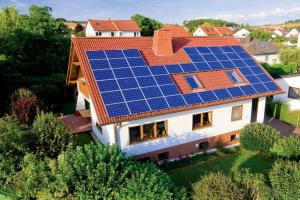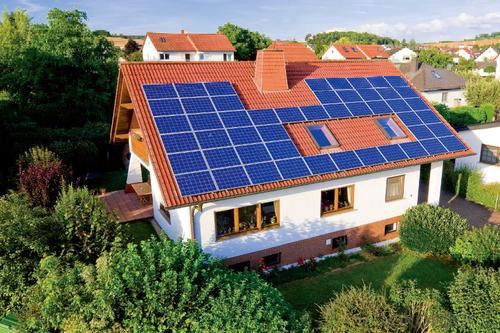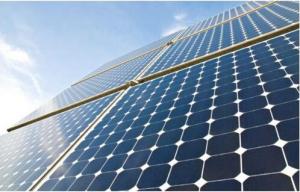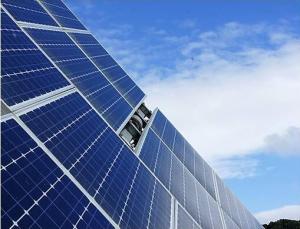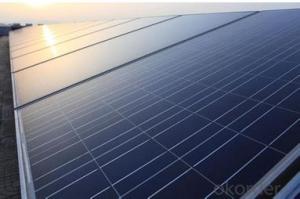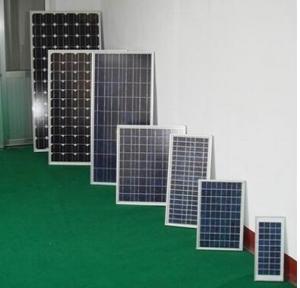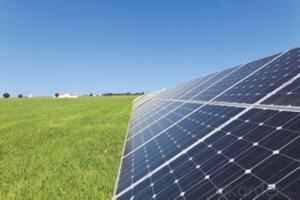San Jose Solar Panels - Polycrystalline Silicon Solar Modules 48cell-205w
- Loading Port:
- China Main Port
- Payment Terms:
- TT or LC
- Min Order Qty:
- 1000 watt
- Supply Capability:
- 10000000 watt/month
OKorder Service Pledge
OKorder Financial Service
You Might Also Like
1. Structure of Polycrystalline Silicon Solar Modules 48Cell-205W Description
Solar panel refers either to a photovoltaics (PV) module, a solar hot water panel, or to a set of solar photovoltaics modules electrically
connected and mounted on a supporting structure. A PV module is a packaged, connected assembly of solar cells. Solar panels can be
used as a component of a larger photovoltaic system to generate and supply electricity in commercial and residential applications. Each
module is rated by its DC output power under standard test conditions, and typically ranges from 100 to 320 watts. The efficiency of a
module determines the area of a module given the same rated output – an 8% efficient 230 watt module will have twice the area of a 16%
efficient 230 watt module. There are a few solar panels available that are exceeding 19% efficiency. A single solar module can produce only
a limited amount of power; most installations contain multiple modules. A photovoltaic system typically includes a panel or an array of solar
modules, an inverter, and sometimes a battery and/or solar tracker and interconnection wiring.
2. Main Features of the Polycrystalline Silicon Solar Modules 48Cell-205W
• WARRANTIES
- 10-year limited product warranty1.
- Limited power warranty1: 1 year at 98% of the minimal rated power
output, 10 years at 92% of the minimal rated power output, 25 years
at 82% of the minimal rated power output.
1In compliance with our Warranty Terms and Conditions.
• QUALIFICATIONS & CERTIFICATES
IEC 61215, IEC 61730, MCS, CE, ISO 9001:2008, ISO 14001:2004, BS OHSAS 18001:2007, PV Cycle, SA 8000
3. Polycrystalline Silicon Solar Modules 48Cell-205W Images
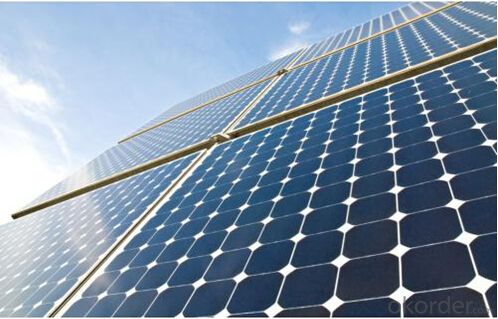
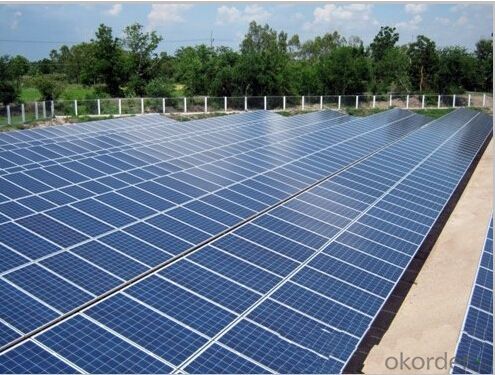
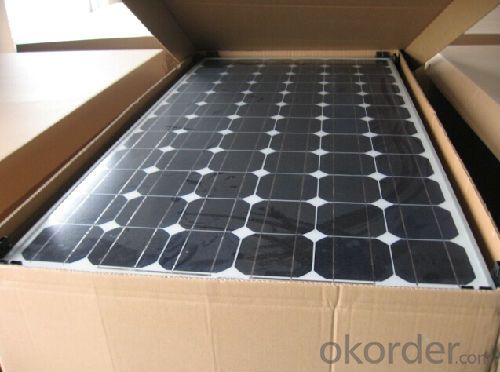
4. Polycrystalline Silicon Solar Modules 48Cell-205W Specification
窗体顶端 ELECTRICAL PERFORMANCE窗体底端 | |||
Power output | P max | W | 205 |
Power output tolerances | ΔP max | W | 0/+5 |
Module effi ciency | η m | % | 15.8 |
Voltage at Pmax | V mpp | V | 24.5 |
Current at Pmax | I mpp | A | 8.36 |
Open-circuit voltage | V oc | V | 30.9 |
Short-circuit current | I sc | A | 8.94 窗体底端 |
5. FAQ of Polycrystalline Silicon Solar Modules 48Cell-205W
Q1:Can we visit your factory?
A1:Sure,welcome at any time,seeing is believing.
Q2:Which payment terms can you accept?
A2:T/T,L/C,Moneygram,Paypal are available for us.
- Q: is this fact true? - its a limitation to solar panels during summer when it's in extremly hot countrie. I've heard it from my science teacher .. please give detail if you have any and any more benefits/limitations is welcomed .. Thank you :) !
- WHAT? This is far from the truth, IN Scottsdale Arizona a small apartment complex was fitted with solar {photo voltaic cells in the late 70s. Every summer they sold electricity back to the power company. It gets up to 5 fairly often here, and as hot as 23 in the shade. On a roof top it is over 50 in direct sunlight. The opposite is true. When it is cloudy they produce less electricity. They may loose some efficiency when it is very hot, but not enough to make them not work at all, or even enough to really harm the output to any really appreciable extent. A new plastic photovoltaic material that produces about 40-45% of a silicon based solar cell is a neat option as it works when it is very cloudy, you can drive nails through it, and it is flexible. I think these items are kept artificially expensive by big business, but this is just a biased opinion of mine, but as far as not working in extreme heat, NO these solar panels work just fine when it is hot. I am in Phoenix Arizona, and it does not get a whole lot hotter than here. If the cells from the 970s worked OK newer ones are better and will do just fine too. Solar hot water heaters are a slightly different matter as they will over heat the water and the water must be mixed with cooler water, or you can really get into trouble. Maybe this is what he meant. Still I doubt it is enough of an issue to cause the device to be less efficient than a gas water heater, or electric, etc. Maybe he is referring to having to mix cooler water into solar heated water in a solar hot water heater, or some other system, Photovoltaic cells do not have any problems rendering them useless from hot weather on this planet, and in fact, they are used in space and it gets much hotter there.
- Q: Hello Yahoo, I am doing another one of my wacky inventions however I need something that will give me 2V of power!I don't want to connect loads of AA batteries into a battery holder as this shall run out quickly and become expensive in the long run, I don't want to carry around a big car battery either.I have been searching around on OKorder .uk and found some Solar-Powered 2V Trickle Chargers. These say they shall work on cloudy days (which is perfect as the majority of the time that is all we get!) but could I use it as an independent power source?If I attached the thing I want to run to the solar panel will it supply it with 2V of power?
- How many amps will you need? Remember v x a = power. The way those trickle chargers work is by sacrificing some amperage to get up to 2 volts. If you can invent closer to ~3V range that solar cells naturally produce thing will likely work better. A sign or a light that doesn't need a lot of power will work. Automobile battery packs might take a month to charge. Solar-Powered 2V Trickle Chargers are used mostly to keep things like boat batteries in storage from discharging, not to charge them.
- Q: I read on CNN's website last year some company was creating a very cheap type of solar panel, that needs minimal maintenance and and has minimal glare from the sun. And the creator of the project said he one day wanted to cover every rooftop in the US with these solar panels. Seems like a good idea to me but I havent heared anything of it for a long time and I don't know what they are called... any help?
- Solar panels are one of the hottest areas in materials research today - from basic science to applied production techniques. There have been major strides in thin-film manufacturing technique as well as silicon technology. There's not a lot of hype about it because solar panel manufacturers don''t really need to advertise yet - they are selling at factory capacity with demand for more. Standard silicon solar panels now sell for around $3 a watt, and grid parity is expected within 5 years. Reference is to the MIT Technology Newsletter, which runs several articles a month on new solar tech.
- Q: Can solar panels be used in areas with high levels of insect activity?
- Yes, solar panels can be used in areas with high levels of insect activity. While insects may occasionally land on the panels, their presence does not significantly affect the performance or efficiency of solar panels. Proper installation and regular maintenance can help minimize any potential issues caused by insects.
- Q: Can solar panels be used to power air conditioning or heating systems?
- Yes, solar panels can be used to power air conditioning and heating systems. Solar panels convert sunlight into electricity, which can be used to power various appliances and systems in a building, including air conditioning and heating units. This is achieved by connecting the solar panels to an inverter, which then converts the generated DC electricity into AC electricity that can be used to run these systems. By utilizing solar power, it is possible to reduce reliance on traditional energy sources and reduce carbon emissions associated with air conditioning and heating.
- Q: Can solar panels be installed on a military base or facility?
- Yes, solar panels can be installed on a military base or facility. In fact, many military bases worldwide have already embraced solar energy as a part of their sustainability initiatives. Solar panels provide a reliable and renewable source of electricity, reducing the reliance on fossil fuels and enhancing energy security. Additionally, they contribute to cost savings and help meet environmental goals for reducing carbon emissions.
- Q: Aren't batteries bad for the environment?Toxic?Expensive? With small solar panels phones, iPod's, laptops other small electronics could be smaller, slimmer, more efficient cost people less to charge every day. Maybe a small battery inside as a backup and to store the Solar energy for night time. But overall, batteries should be optional. So big question:Why aren't electronics being produced with solar panels?
- Actually, I have gone through quite a few solar powered radios-though they had rechargeable batteries. Still have a solar powered flashlight. Leave 'em out in the sun for a few hours and your get an hour of radio, or a day or so of light. That doesn't get rid of the batteries thought (Which are built-in rechargables)
- Q: Can solar panels be used to power a cruise ship?
- Yes, solar panels can be used to power a cruise ship, but it may not be the sole source of power due to the large energy demands of a cruise ship. However, solar panels can contribute to the overall energy supply of a cruise ship, reducing its reliance on fossil fuels and decreasing its environmental impact.
- Q: Can solar panels be used to power a water pump?
- Yes, solar panels can be used to power a water pump. Solar panels convert sunlight into electricity, which can then be used to power a water pump. This allows for a sustainable and renewable energy source to operate the pump without relying on conventional electricity grids or fossil fuels.
- Q: Hello,What do you all think about the future of solar panels and what role they will play in the near future. There is tons of money being dumped into the industry and demand is slowly rising. Also do you have any favorite solar links to get more info about them?
- Solar Panel really isn't any new technology, it was discovered in the early 60s. And as you can see it hasn't progressed all that much. But Developers are saying that within the next five years solar technology will increase dramatically. With more and more people looking for greener and easier forms of energy, there are many looking towards solar. In fact some energy companies are willing to buy the energy that you produce from you. And with new forms of thinner silicon panels, we are looking at a more efficient kind of panels. Unfortunately for us, at the moment thin-film panel silicon isn't as efficient as we are looking for. They are flimsier than the traditional panels and do not contain as much silicon to produce the electricity. But as soon as the demand increases, the production will increase, and if more companies are looking to invest in solar, then there will be more competition, with more competition- we are going to have improved technology, and with more improved technology, the prices will go down. Because at the moment, there is not much of an incentive for solar power. Compared to the Kilowatt- hour produced from coal and other forms of energy, solar does not produce as much. Experts are saying that within the next five years, not having solar panels on your house will be as silly as building a house without plumbing. The future on solar panels looks bright.
Send your message to us
San Jose Solar Panels - Polycrystalline Silicon Solar Modules 48cell-205w
- Loading Port:
- China Main Port
- Payment Terms:
- TT or LC
- Min Order Qty:
- 1000 watt
- Supply Capability:
- 10000000 watt/month
OKorder Service Pledge
OKorder Financial Service
Similar products
Hot products
Hot Searches
Related keywords
